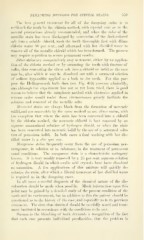Page 561 - My FlipBook
P. 561
BLEACHING METHODS FOR SPECIAL STAINS. 559
The best general treatment for all of the foregoing stains is to
re-bleach the tooth by the chlorin method, with especial care as to the
several precautions already recommended, and when the color of the
metallic stain lias been discharged bv conversion of the dark-colored
salt into a soluble chlorid, wash the tooth thorouglily first with dilute
chlorin water 50 per cent., and afterward with hot distilled water to
remove all of the metallic chlorid which has been formed. The process
may require roj)etition to secure permanent results.
Silver stains are comparatively easy to remove, either by an applica-
tion of the chlorin method or by saturating the tooth with tincture of
iodin, thus converting the silver salt into a chlorid or iodid as the case
may be, after which it may be dissolved out with a saturated solution
of sodium hyposulfite applied as a bath to the tooth. For this pur-
pose the Hollingsworth bulb dam (see Fig. 483) answers admirably,
and although the experiment has not as yet been tried, there is good
reason to believe that the cataphoric method with electrodes applied in
reverse order would under these circumstances greatly facilitate the
solution and removal of the metallic salts.
Mercurial stains are always black from the formation of mercuric
sulfid,and are removable by the same method as are silver stains, with
the exception that where the stain has been converted into a chlorid
by the chlorin method, the mercuric chlorid is best removed by an
aqueous ammoniacal solution of hydrogen dioxid, or when the stain
has been converted into mercuric iodid by the use of a saturated solu-
tion of potassium iodid. In both cases a final Avashing with hot dis-
tilled water is a sine qua non.
llanganese stains frequently occur from the use of potassium per-
manganate, in solution or in substance, in the treatment of putrescent
canal conditions. The manganese stain is a characteristic mahogany
brown. It is very readily removed by a 25 per cent, aqueous solution
of hydrogen dioxid in which oxalic acid crystals have been dissolved
to saturation. A few applications of this mixture will quickly de-
colorize the stain, after whicli a liberal treatment of hot distilled water
is required as in the foregoing cases.
In all cases a careful diagnosis of the chemical nature of the dis-
coloration should be made when possible. Much information upon this
point may be gained by a detailed study of the present condition of the
tooth and its environment, but in addition to this the patient should be
questioned as to the history of the case, and especially as to its previous
treatment. The data thus obtained should be carefully noted and treat-
ment instituted in accordance wdth the conditions to be met.
Success in the bleachino: of teeth demands a recotrnition of the fact
that each case presents individual peculiarities, that the problem is


